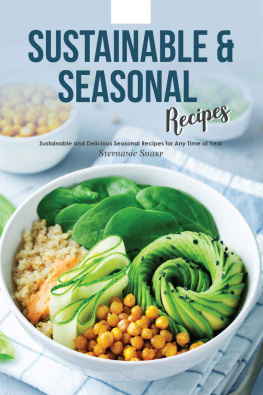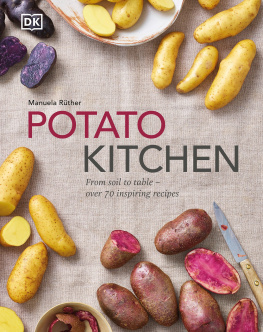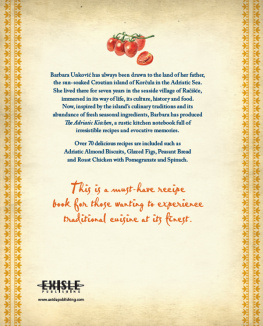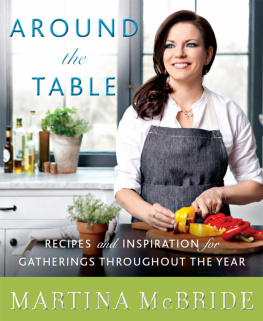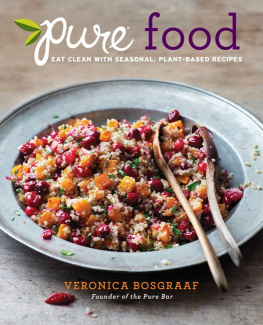Rosehips on a Kitchen Table
SEASONAL RECIPES FOR FORAGERS & FOODIES
CAROLYN CALDICOTT
PHOTOGRAPHS BY CHRIS CALDICOTT FOOD STYLING BY CAROLYN CALDICOTT

First published in 2014
by Frances Lincoln Ltd, 7477 White Lion Street, London N1 9PF
www.franceslincoln.com
This eBook edition first published in 2014
Rosehips on a Kitchen Table
Copyright Frances Lincoln 2014
Text copyright Carolyn Caldicott 2014
Photographs copyright Chris Caldicott 2014-02-06
Food styling by Carolyn Caldicott
Designed by Becky Clarke
All rights reserved
This eBook is copyright material and must not be copied, reproduced, transferred, distributed, leased, licensed or publicly performed or used in any way except as specifically permitted in writing by the publishers, as allowed under the terms and conditions under which it was purchased or as strictly permitted by applicable copyright law. Any unauthorised distribution or use of this text may be a direct infringement of the authors and publishers rights, and those responsible may be liable in law accordingly
A catalogue record for this book is available from the British Library
eBook conversion by Quarto Publishing Group USA
Digital edition: 978-1-7810-1143-0
Softcover edition: 978-0-71123-388-1
Contents
Rich Pickings

Y ou dont have to be an expert cook, gardener or forager to make the most of this book - you just have to love good seasonal food.
In Rosehips on a Kitchen Table we show you how you can use old-fashioned methods - with a contemporary twist - to turn gluts, wild pickings and long-neglected ingredients into quick lunches, inventive suppers and divine desserts. Maybe we can even tempt you to dabble in the world of grow your own. Convert the gnarled and knobbly, weird and wonderful, into jams and jellies, chutneys, pickles, pesto and cordials. Plunge in with an open mind and get cooking!
Useful things to know
A few phrases that pop up a lot are blanch, setting point, sterilize and seal.
To blanch vegetables, bring a pan of water to a brisk boil, dunk the prepared vegetables in the water, drain, then refresh with cold water.
The setting point is the point at which a jam or jelly will set once cooled. To test, spoon a teaspoon of the jam or jelly on to a cold saucer. Leave it for a minute or two to cool, then push it with your finger. If the surface wrinkles the jams ready to set. If its still runny, boil for a little longer and test again.
I find that the easiest way to sterilize jars and bottles is first to wash the jars and lids in hot, soapy water, then place them in an oven and set the oven temperature to 100C/200F. When the oven is up to temperature the jars and lids are ready to use.
To store jam or jelly, ladle the fruit mixture into sterilized jars as soon as the setting point is reached. Cover the jam with a waxed jam disc (waxed side down). You can then either seal with a tight-fitting lid or use a cellophane jam cover: moisten the cellophane with a drop of water, stretch over the jar (damp side up) and secure with a rubber band. (Whichever way you choose, the jars will look very pretty covered with fabric or coloured paper available from good cooks shops, or make your own.) Syrups are best stored in sterilized screw-top bottles. Store chutneys and vinegars in jars with plastic-lined lids or in Kilner jars or bottles with rubber-sealed clips.
Dont discard old jars and bottles; you never know when theyll come in handy.
Have a selection of labels to hand: you dont want to get your dates mixed up.
A hand-operated mouli is a useful tool to invest in. It makes light of any sieving job. Maybe you even have one lurking in the back of a cupboard?
A jelly bag is a fine mesh fabric bag especially designed to strain fruit. To scald the bag, iron both sides with an iron heated to a medium temperature or immerse in boiling water for a few minutes.
Wash all vegetables and fruit thoroughly before use.
When using the recipes in this book, please follow either metric or American measurements. Dont mix the two they are not exact equivalents.
Recipes are for 4 greedy or 6 moderate people, unless otherwise stated.
Gleaning

T heres nothing quite as satisfying as foraging for free wild food. A handful of nettles for a warming soup, some wild garlic to whizz with olive oil to make a simple pesto, rosehips for a jelly packed with vitamin C? Its all out there for the picking, even in the city, as long as you know what to look for.
Keep your eyes open and always be prepared with a handy spare bag in your pocket. A stout walking stick can also be very useful to hook a stray branch; you can bet the biggest and best produce is just out of arms reach.
Whether in the town or the country, stick to a few basic rules; pick produce well away from the path or road; if theres only a small amount leave it to grow; never dig up a plant; and, most important, if in doubt dont pick it! Once at home with your bounty make sure to wash everything thoroughly before you eat it.
Once youve been bitten by the foraging bug youll be amazed how much wild produce there is around. As the seasons progress new treats constantly reveal themselves. Blackberries climbing over a park fence, a rogue apple or damson tree; another one for the list. All my secret locations are carefully documented in a treasured battered notebook as a reminder for next year. So get out there and get picking: the rewards are huge.
Wild Garlic
In early spring, when snowdrops raise their nodding headsb, the first optimistic shoots of wild garlic push through the earth. As the days start to warm, the shoots erupt into a bright green carpet of long, pointed leaves, garlanded with delicate white flowers.
A member of the Allium family, wild garlic, or ramson, flourishes in moist wooded areas and is instantly recognizable by the strong smell of garlic! Once picked the leaves keep well when stored in the fridge, so dont be shy about how much you take. Remember to pick a posy of the edible white flowers: they make a tasty, pretty garnish for any wild garlic recipe.


